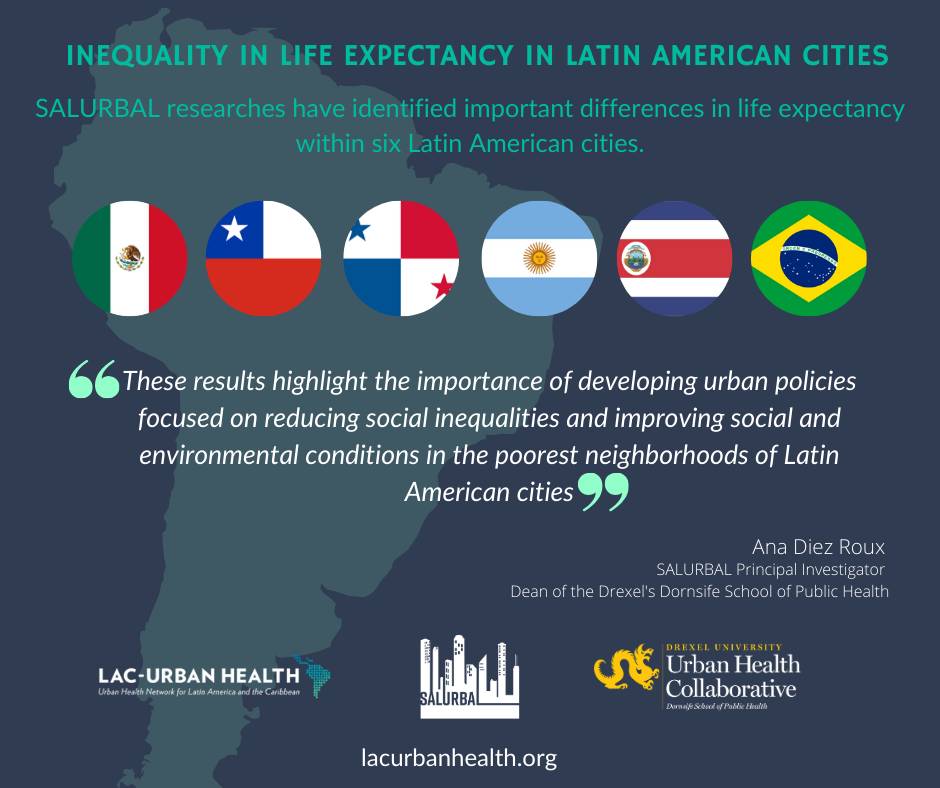Study Highlights Differences in Life Expectancy Between Neighborhoods in Six Latin American Cities
Philadelphia, Pennsylvania, USA,
December 11, 2019
PRESS RELEASE
A recent investigation carried out by the Salud Urbana en América Latina (SALURBAL) project and published in The Lancet Planetary Health highlights the importance of generating policies to reduce social inequalities in urban areas of Latin America.
The study was conducted by a team of researchers from Argentina, Chile, Guatemala, Mexico, Peru, Brazil, and the United States, and reveals important differences in life expectancy within six Latin American cities. It also highlights the relationship between life expectancy and the socioeconomic status of a person’s area of residence.
“This is the first time that the extreme magnitude of inequalities in life expectancy has been mapped for several cities in Latin America, and it constitutes a fundamental first step towards reducing or eradicating these inequalities in the future,” says first author Usama Bilal, MD, PhD, and assistant professor at Drexel University’s Dornsife School of Public Health.
Between them, the six cities house more than 50 million people. Each city shows important differences in life expectancy according to the area where people live. Santiago de Chile and Panama City are two of the cities with the greatest differences. For example, in Santiago, the gap in life expectancy between areas in the city is almost nine years for men and 18 years for women. Panama City presents a difference of almost 15 years for both men and women. Important inequalities were also observed in Buenos Aires, Belo Horizonte, San José, and Mexico City.
Part of this gap may be explained by socio-economic context, which was determined based on educational level for each area within cities. In the case of Santiago, the difference in life expectancy between areas with the highest and lowest education levels can be up to eight years for men and up to twelve years for women. Describing this type of inequality in the Latin American population is a fundamental step to understanding and addressing the determinants of urban health in the region.
“These results highlight the importance of developing urban policies focused on reducing social inequalities and improving social and environmental conditions in the poorest neighborhoods of Latin American cities,” said SALURBAL principal investigator Ana Diez Roux, MD, PhD, dean of Drexel’s Dornsife School of Public Health.
Click here to read the paper.

Click here to read more about the lessons Philadelphia can learn about inequality in Latin America.
Urban Health in Latin America (SALURBAL) is a research project that aims to study how urban policies and the environment affect the health of residents of Latin American cities. The results of this project will serve as a reference to inform future policies and interventions to make cities healthier, more equitable and sustainable throughout the world. SALURBAL is funded by the Wellcome Trust.
The Lancet Planetary Health is a gold Open Access journal that aims to establish and grow an entirely new field of scientific inquiry—namely, to investigate and provide solutions to the political, economic, social, and environmental determinants of healthy human civilizations and the natural systems on which they depend.
In addition to Bilal and Diez Roux, the other authors of the research include Marcio Alazraqui, PhD, of Instito de Salud Colectiva (Argentina), Waleska Caiaffa, PhD from Universidade Federal de Minas Gerais (Brazil), Nancy Lopez-Olmedo, PhD, from Instituto Nacional de Salud Pública (Mexico) , Kevin Martinez-Folgar, MD, from Drexel University (USA), Jaime Miranda, PhD, from Universidad Peruana Cayetano Heredia (Peru), Daniel Rodriguez, PhD, from University of California, Berkeley (USA), and Alejandra Vives, PhD from Pontificia Universidad Católica de Chile (Chile).
For more information, maps and graphs contact Andrea Bolinaga at ab4488@drexel.edu